WHAT'S NEW:
Eruption Confirmed!
New lava (rumbleometer stuck in flow) SE rift zone
(posted 9/1/98)
BACKGROUND:
Technology (ROV, ships, etc.)
Other 1998 Axial cruise reports
EXPEDITION:
Science Objectives
Calendar
Today's Science News
Participant Perspective
Teacher Logbook
EDUCATION:
Curriculum
Teacher Observations
Questions/Answers from sea
MULTIMEDIA:
(video clips, animations, sounds)
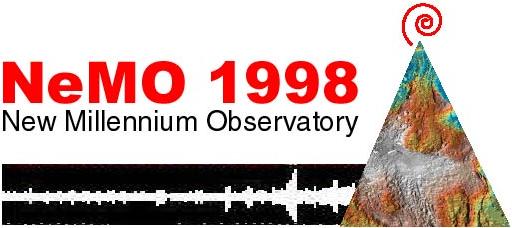
Logbook
September 8, 1998
September 8, 1998
Contents:
Science Report
Daily Science Report - Sep 8
ship's location = 45 56.0N/130 00.8W
ROPOS dive 469 to the ASHES vent field came back with the fluid sampler full of samples, after 14 hours on the bottom. This was the first full dive with the fluid sampler and everyone was happy to see it working well (thanks again to theAir Force). Some of the fluid samples will be used to analyze the chemical composition of the vent fluids and some will be used for microbiolgical studies.
Series of photos showing the recovery of the
extensometer being recovered from 2 years on seafloor. The instruments had to be manually released by ROPOS and brought to the surface using an elevator.
Ship's crew launched a boat to bring the package to the ship and then hoisted it aboard using the ship's crane. Scientist responsible for the extensometer,
Bill Chadwick, stands by the recovered instruments and below begins to disassemble the parts in order to download the data.
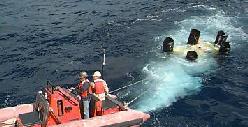
|
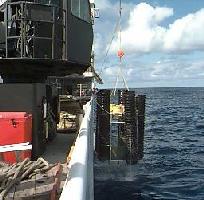
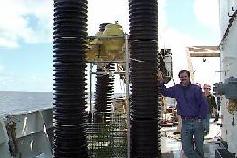
|
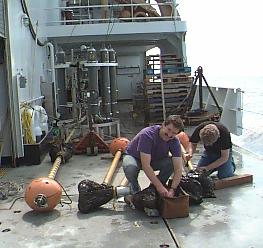
This morning we tried to release the anchor from the elevator mooring with the extensometer instruments in it (that we loaded up on ROPOS dive 467) by sending an acoustic command from the ship, but it refused to come back to the surface. We were forced to send ROPOS down after it, since it also can be mechanically released by ROPOS. This became dive 470 and lasted all of 30 minutes on the bottom, and then ROPOS returned to the surface. Within about 45 minutes the elevator surfaced right next to the ship and the whole thing was hoisted on board. When every you put anything over the side and drop it into the ocean, you never know if it will come back, so it was a good feeling to see the extensometer instruments come back on board. We are now in the process of downloading the data that they have collected over the last 2 years. Preparations are underway for the next dive at ASHES.
Our first 10 dives with ROPOS have amounted to 147 hours of bottom time, or an average of ROPOS has been a work horse!
Listing of all Science News postings
Life at Sea: Participant Perspective
Mike Stapp
NOAA PMEL,
Engineering Division
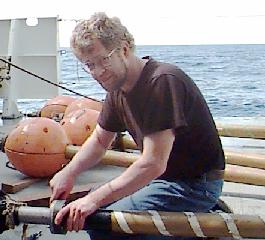 Hello from the NOAA ship Brown. My name is Mike Stapp and I am an electronics
engineer at the
Pacific Marine Environmental Laboratory in Seattle. My primary
duty on this cruise is to repair the electronics in scientific instruments that
fail. I have been spending most of my time helping
Dave Butterfield get his
fluid sampler working. Since it is a new instrument, there were a few bugs that
didn't show themselves until we attempted to run it at sea. We were lucky enough
to be able to have the
Air Force drop off a new circuit board when a chip failed
at sea. It is always a challenge to repair electronics at sea where you always
seem to be missing the one crucial spare component or circuit diagram. We were
able to find a substitute sample pump in another instrument on board when one of
the fluid sampler's pumps started operating intermittently. The fluid sampler
is operating well now, which should make quite a few scientists on the Brown
happy!
Hello from the NOAA ship Brown. My name is Mike Stapp and I am an electronics
engineer at the
Pacific Marine Environmental Laboratory in Seattle. My primary
duty on this cruise is to repair the electronics in scientific instruments that
fail. I have been spending most of my time helping
Dave Butterfield get his
fluid sampler working. Since it is a new instrument, there were a few bugs that
didn't show themselves until we attempted to run it at sea. We were lucky enough
to be able to have the
Air Force drop off a new circuit board when a chip failed
at sea. It is always a challenge to repair electronics at sea where you always
seem to be missing the one crucial spare component or circuit diagram. We were
able to find a substitute sample pump in another instrument on board when one of
the fluid sampler's pumps started operating intermittently. The fluid sampler
is operating well now, which should make quite a few scientists on the Brown
happy!
I am also helping Gary Massoth with the SUAVE (Gary named it, not me!) chemical sampler whose software and electronics I designed . Gary has been using the SUAVE very successfully for several years now but there has always been a problem with the valve used to switch in the standards for calibration. We are using a new valve on this cruise which looks like it will work more reliably and ease Gary's data analysis.
I will also be helping Bill Chadwick with recovering and re-deploying the acoustic extensometers (see above science report) whose software and electronics I designed . These 5 instruments were deployed 2 years ago and the plan is to use ROPOS to recover them from the sea floor, retrieve the data, and then re-deploy them with new batteries. These instruments are designed to operate for 1 year so it will be interesting to see how long they last beyond that. When I get back to PMEL I will be continuing work on a new extensometer designed to last 5 years on the sea floor. Besides having more batteries than the current version, it will have an acoustic modem so a ship can stop by every year and retrieve the data without having to recover the instrument from the bottom. I should have had the design finished before this cruise but it seems that electronics and software design never go as quickly as one would like!
Listing of all Perspectives postings
Teacher At Sea Logbook
September 8 - 0800 hours
Uh-oh! The teacher made a mistake. It was either a case of brain lock or I was on auto-pilot several days ago when I reported that transponders signal each other with radio signals. The reason that submarines have to come to the surface to use radio communication is that radio signals don't transmit through water. Transponders actually communicate with each other using acoustic, or sound signals. Now that I have admitted to the only mistake I have ever made in my life, I am ready to explain how transponders are going to be important in the work that we are doing today.
You may remember that three days ago, just before the storm, we had
picked up
the five extensometers from the sea floor and deposited them in the elevator.
The elevator and the extensometers have been parked on the sea floor ever since,
held in place by a wheel from a railroad car. Yes, you read it right,
Old
railroad car wheels are one of the most popular items used to anchor equipment
to the sea floor.
Not only are they plenty heavy, but when they are left behind
the simply rust away. Any plankton specialist will tell you that lack of iron
in the water is the a limiting factor in the growth of single celled organisms
in the sea. So you might say that far from adding to the pollution problem in
the sea, the wheels are adding much needed nutrients.
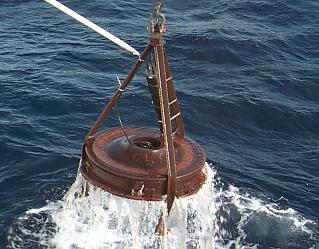
Back to the extensometers. There has been a bit of a problem in communicating with the release mechanism that holds the elevator to the anchor. We are in the process of moving the navigation and ranging from the ROPOS cage to a device known simply as El Guapo, the handsome one. El Guapo (photo left) got its name because it is one of the ugliest pieces of equipment on board. El Guapo should allow us to transmit the release codes to the elevator, and then floats attached to the elevator will cause it to rise at a rate of about 1 meter per second, bringing it to the surface in about 45 minutes. There is a flashing strobe atop the elevator that will allow us to spot it on the surface. It was interesting to watch the ROPOS operators navigating back to the elevator with each of the extensometers. Instead of navigating with the usual bank of bright lights used on other dives, the pilot would turn off the lights and simply look for the flashing strobe which is easy to see at considerable distance in the inky blackness of the deep sea. The lights were turned back on only when it was time to deposit the extensometer into its plastic tube on the elevator.
0900 hours
Attempts to communicate with the elevator have failed. Fortunately there is a backup plan. ROPOS can dive down and grab a release cable on the elevator, manually releasing it from the bottom. This will be a quick dive for ROPOS. Just down and back. After we have recovered the elevator ROPOS will be outfitted for the next science dive.
1200 hours
ROPOS has just released the elevator from the ocean floor. We have about a one hour wait for the elevator to reach the surface. The ship is being positioned for recovery and then we are off again for another dive on Ashes. That dive will probably not begin until late this evening, so I hope to have some new information from that dive site tomorrow.
Logbook of all Teacher At Sea postings
Question/Answer of the Day
Send Your Question to NeMO
(oar.pmel.vents.webmaster@noaa.gov)
Back to Calendar